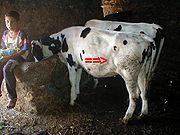
Tropical theileriosis
Encyclopedia
Tropical theileriosis or Mediterranean theileriosis is a theileriosis
of cattle
from the Mediterranean and Middle East
area, from Morocco
to Western parts of India
and China
.
It is a tick-borne disease
, caused by Theileria annulata. The vector tick
s are of the genus Hyalomma
.
The most prominent symptoms are fever
and lymph node enlargement
. But there is a wide range of clinical manifestations, especially in enzootic
areas. Among them, the Doukkala
area of Morocco
, where the epidemiology and symptomatology of the disease were minutely studied.
 The disease was once considered as "benign" in the literature, in comparison to East coast fever
The disease was once considered as "benign" in the literature, in comparison to East coast fever
. But with the introduction of European breeds into the region, it could become of major economic incidence.
An efficient treatment with parvaquone, then buparvaquone
became available in many countries from the mid 1990s.
Animals native to endemic areas appear more tolerant to the disease, buffalos especially, appear less susceptible.
 Body temperature is regularly higher than in any other cattle disease. Fever from 41 to 42°C is common in acute stages. Later on (day 5 to day 10 from the clinical onset), temperature will lower to a normal range (38.0–39.5°C), but the disease will continue to progress, despite a possible apparent clinical improvement (appetite comes back). Afterwards, from D10 to D15, there is a downfall stage, with hypothermia
Body temperature is regularly higher than in any other cattle disease. Fever from 41 to 42°C is common in acute stages. Later on (day 5 to day 10 from the clinical onset), temperature will lower to a normal range (38.0–39.5°C), but the disease will continue to progress, despite a possible apparent clinical improvement (appetite comes back). Afterwards, from D10 to D15, there is a downfall stage, with hypothermia
(37 to 38°C), anemia
, subicterus, and heart failure. Such animals rarely recover, even with intensive treatment.
Lymph nodes are commonly enlarged and there may be episodes of blood from the nose, difficulty breathing and weight loss.
Other signs, but not present in all cases are :
 Lymph node enlargement and even hyperthermia can occur asymptomatically in enzootic area, during the disease season.
Lymph node enlargement and even hyperthermia can occur asymptomatically in enzootic area, during the disease season.
Hence, diagnosis must be based on objective pathological signs like anorexia or drastic reduction of milk production in dairy cows.
Definitive diagnosis relies on the observation of the organism in blood smears. Lymph node aspirates can also be examined. Post-mortem examination, ELISA
and PCR can also help diagnosis.
, halofuginone
and tetracycline have all shown to be effective. Tick control should be considered, but resistance to parasiticide products may be increasing.
Endemic stability is a state where animals are affected at a low levels or not as susceptible to the disease, and this may be encouraged in endemic areas.
Vaccination is available and should be performed in breeds that are susceptible to infection.
Theileria
Theileria is a genus of parasitic protozoan that belongs to the phylum Apicomplexa and is closely related to Plasmodium. Two Theileria species, T. annulata and T. parva, are important cattle parasites. T. annulata causes tropical theileriosis and T. parva causes East Coast fever. Theileria are...
of cattle
Cattle
Cattle are the most common type of large domesticated ungulates. They are a prominent modern member of the subfamily Bovinae, are the most widespread species of the genus Bos, and are most commonly classified collectively as Bos primigenius...
from the Mediterranean and Middle East
Middle East
The Middle East is a region that encompasses Western Asia and Northern Africa. It is often used as a synonym for Near East, in opposition to Far East...
area, from Morocco
Morocco
Morocco , officially the Kingdom of Morocco , is a country located in North Africa. It has a population of more than 32 million and an area of 710,850 km², and also primarily administers the disputed region of the Western Sahara...
to Western parts of India
India
India , officially the Republic of India , is a country in South Asia. It is the seventh-largest country by geographical area, the second-most populous country with over 1.2 billion people, and the most populous democracy in the world...
and China
China
Chinese civilization may refer to:* China for more general discussion of the country.* Chinese culture* Greater China, the transnational community of ethnic Chinese.* History of China* Sinosphere, the area historically affected by Chinese culture...
.
It is a tick-borne disease
Tick-borne disease
Tick-borne diseases are diseases or illnesses transmitted by ticks. As the incidence of tick-borne illnesses increases and the geographic areas in which they are found expand, it becomes increasingly important that health professionals be able to distinguish the diverse, and often overlapping,...
, caused by Theileria annulata. The vector tick
Tick
Ticks are small arachnids in the order Ixodida, along with mites, constitute the subclass Acarina. Ticks are ectoparasites , living by hematophagy on the blood of mammals, birds, and sometimes reptiles and amphibians...
s are of the genus Hyalomma
Hyalomma
Hyalomma is a genus of hard-bodied ticks, common in Asia, Europe, and Hyalomma is a genus of hard-bodied [[tick]]s, common in [[Asia]], [[Europe]], and...
.
The most prominent symptoms are fever
Fever
Fever is a common medical sign characterized by an elevation of temperature above the normal range of due to an increase in the body temperature regulatory set-point. This increase in set-point triggers increased muscle tone and shivering.As a person's temperature increases, there is, in...
and lymph node enlargement
Adenitis
Adenitis is a general term for an inflammation of a gland or lymph node.-Lymph node adenitis:"Lymph adenitis" or "lymph node adenitis" is caused by bacterial infection in lymph nodes. The infected lymph nodes typically become enlarged, warm and tender. A swelling of lymph nodes due to growth of...
. But there is a wide range of clinical manifestations, especially in enzootic
Enzootic
Enzootic is the non-human equivalent of endemic and means, in a broad sense, "belonging to" or "native to", "characteristic of", or "prevalent in" a particular geography, race, field, area, or environment; native to an area or scope....
areas. Among them, the Doukkala
Doukkala
Doukkala is a natural region of Morocco, included in the province of El Jadida and in the Abda-Doukkala administrative region....
area of Morocco
Morocco
Morocco , officially the Kingdom of Morocco , is a country located in North Africa. It has a population of more than 32 million and an area of 710,850 km², and also primarily administers the disputed region of the Western Sahara...
, where the epidemiology and symptomatology of the disease were minutely studied.

East Coast fever
-Introduction:East Coast fever is a disease of cattle, sheep and goats caused by the protozoan parasite Theileria parva. The term excludes diseases caused by other Theileria, such as tropical theileriosis , caused by T. annulata, and human theileriosis, caused by T...
. But with the introduction of European breeds into the region, it could become of major economic incidence.
An efficient treatment with parvaquone, then buparvaquone
Buparvaquone
Buparvaquone is a hydroxynaphthoquinone antiprotozoal drug related to parvaquone and atovaquone. It is a promising compound for the therapy and prophylaxis of all forms of theileriosis. Buparvaquone has been shown to have anti-leishmanial activity in vitro...
became available in many countries from the mid 1990s.
Animals native to endemic areas appear more tolerant to the disease, buffalos especially, appear less susceptible.
Clinical symptoms

Hypothermia
Hypothermia is a condition in which core temperature drops below the required temperature for normal metabolism and body functions which is defined as . Body temperature is usually maintained near a constant level of through biologic homeostasis or thermoregulation...
(37 to 38°C), anemia
Anemia
Anemia is a decrease in number of red blood cells or less than the normal quantity of hemoglobin in the blood. However, it can include decreased oxygen-binding ability of each hemoglobin molecule due to deformity or lack in numerical development as in some other types of hemoglobin...
, subicterus, and heart failure. Such animals rarely recover, even with intensive treatment.
Lymph nodes are commonly enlarged and there may be episodes of blood from the nose, difficulty breathing and weight loss.
Other signs, but not present in all cases are :
- Blood-tinted diarrheaDiarrheaDiarrhea , also spelled diarrhoea, is the condition of having three or more loose or liquid bowel movements per day. It is a common cause of death in developing countries and the second most common cause of infant deaths worldwide. The loss of fluids through diarrhea can cause dehydration and...
, or with obvious blood clots.
Diagnosis

Hence, diagnosis must be based on objective pathological signs like anorexia or drastic reduction of milk production in dairy cows.
Definitive diagnosis relies on the observation of the organism in blood smears. Lymph node aspirates can also be examined. Post-mortem examination, ELISA
ELISA
Enzyme-linked immunosorbent assay , is a popular format of a "wet-lab" type analytic biochemistry assay that uses one sub-type of heterogeneous, solid-phase enzyme immunoassay to detect the presence of a substance in a liquid sample."Wet lab" analytic biochemistry assays involves detection of an...
and PCR can also help diagnosis.
Treatment and control
BuparvaquoneBuparvaquone
Buparvaquone is a hydroxynaphthoquinone antiprotozoal drug related to parvaquone and atovaquone. It is a promising compound for the therapy and prophylaxis of all forms of theileriosis. Buparvaquone has been shown to have anti-leishmanial activity in vitro...
, halofuginone
Halofuginone
Halofuginone is a coccidiostat used in veterinary medicine. It is a synthetic halogenated derivative of febrifugine, a natural quinazolinone alkaloid which can be found in the Chinese herb Dichroa febrifuga . Collgard Biopharmaceuticals is developing halofuginone for the treatment of scleroderma...
and tetracycline have all shown to be effective. Tick control should be considered, but resistance to parasiticide products may be increasing.
Endemic stability is a state where animals are affected at a low levels or not as susceptible to the disease, and this may be encouraged in endemic areas.
Vaccination is available and should be performed in breeds that are susceptible to infection.

